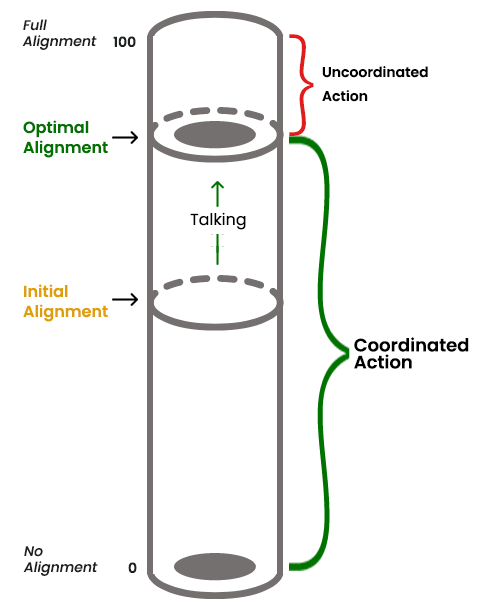
In meetings related to group decisions, strategies, and initiatives, the leader may ask those present, “Let’s get aligned.” The request may come as “Let’s get on the same page.” or “Let’s make sure we’re singing from the same hymn sheet.”
At the meeting’s close, the leader might declare, “I believe we are aligned.”, or ask, “Are we aligned?” If unsure or suspect not, it might be asked as a challenge, “The train is leaving the station. Is anyone still on the platform?”
Then there is the genuine question, without inflection, “Are we aligned?”. The command, “Let’s get aligned.” And the command masquerading as a question, “Are we aligned?” where the only safe response is, “Yes.”
Or, the word alignment is never mentioned because everyone knows they’re not.
Judgments of group alignment range from the serious, “They are not aligned!” to the ironic, “Well, they aren’t on the same page, are they.”
Whichever phrase is used, they all convey the same concept; either a group is aligned, or it is not. In organizational culture, alignment is binary, 0 or 1, True or False, Yes, we are, or No, we aren’t.

Business books with align and alignment in the title offer to teach leaders ways to create alignment. Professional services firm websites offer to get teams, departments, and whole companies aligned.
There is no half-measure, no almost, no partial. Either we are aligned, or we are not. And not being aligned is a bad thing. A group decision, strategy, or initiative is unlikely to succeed with misaligned participants. On a personal level, few participants want to be viewed as not-aligned.
This binary framing of alignment makes sense from a management perspective. If the response to a group leader asking, “Are we aligned?” is yes, they can move to the next task. Otherwise, the group is stalled until the misalignment problem is solved.

When we ask leaders, facilitators, and consultants how they determine whether a group is aligned, they assess it based on people’s words, actions, inaction, and writings. Sometimes, with a little survey data to provide numerical credibility. Indirect and incomplete, a group’s alignment has been a subjective inference.
Beyond a group’s leaders, each member, to lesser and greater degrees, is tacitly or intentionally judging alignment within and between everyone else. Nine people, nine private subjective inferences about each other.
We learned that these rational and logical inferences are almost always widely optimistic or pessimistic. It is understandable; mathematically, the task is too complex to produce accurate conclusions. A group of ‘n’ people has n(n-1)/2 pair connections. For example, a 9-member leadership team or project team means each person is trying to assess the alignment between 36 pairs.

Perhaps, at a stretch, that could be feasible if we assessed the alignment around just one statement, such as “We are good at this.” However, our research surfaced that when a group is, for example, creating a strategy, fixing a struggling transformation program, or chartering a new joint venture, they express, on average, 30 different reasons why it’s necessary to do so.
So, each of the nine needs to mentally analyze 36 pair combinations on 30 opinions, making 1,080 mental judgments.

If that is not bad enough, when we also ask groups how they would define a successful strategy, transformation, merger – or whatever the subject is they are aligning around – they express 18 target outcomes, on average. That is another 648 pair alignment judgments by each of the nine team members.
But we are not finished. When we ask groups, “Why won’t it work?” and “How could taking action hurt others, damage other initiatives?” they express 52 concerns, on average. Another 1,872 alignment points.
When we add the initial “Why should you do this?” opinions to the “Success means producing this. . .” opinions and the “But it won’t work because. . .” opinions, each of the nine group members has 3,600 alignment assessments to make.
Finally, when asked, “How would you produce those outcomes?” a group averages over 50 opinions. “To get there, we need to…, we should do…,” and similar action opinions.
Consequently, when you add up all five types of opinion, the answer to whether or not a group of nine is aligned involves over 7,000 measures.
When we add a seven-member board and thirty first-level managers into the nine-person leadership team conversations to grow the group to forty-six, the number of pair connections grows from 36 to 1,035. Being aligned now means 46 people each need to see 144,900 pair/opinion alignments.
Suppose one of those 46 disagrees with another about just one of the opinions. Because alignment is binary, it can only be Yes or No; with 144,899 Yes and 1 No, you have to state the group is misaligned.
How can it be reasonable for anyone to ask a group to get aligned, ask if they are aligned, or promise to get a group aligned with this impractical all-or-nothing concept of alignment?
In over 330 strategies, transformations, programs, mergers, joint ventures, critical decisions, policy developments, process improvements, product/service innovations, and similar group topics involving Fortune 100 corporate strategy to White House policy to early-stage ventures and not-for-profits, we found the following:
Some of the groups in the research were just one or two weeks after finishing a formal, structured, strategic planning process and heading into implementation.
Rather than treating alignment as binary, Yes or No, please consider it a dynamic characteristic of a group, measurable on a scale.
Using mathematics to objectively quantify a group’s Degree of Alignment – derived from Nobel prize recipient for Economics, 2005, Professor Thomas Schelling’s work – every group was between 44 and 85 on a scale of 0 to 100. I.e., not a single group was close to being fully aligned.
Of note, when we isolated the Degree of Alignment of the executives and leadership teams in 133 of the projects, only four were above 85, the lowest level required for quality coordinated action. The other 129 executive groups were below it. In some cases, these were executive teams who had sponsored several-hundred-million-dollar transformations, mergers, and large-scale change programs.
These research results are why the first part of the title claims that no group was ever aligned. How do we project that forward and say no current or future group will ever be aligned?
First, if every member of that 46-person board/executives/managers group needs to see agreement across 144,900 pair/opinion combinations, it is unreasonable to expect alignment if we use the binary ‘Yes/No’, ‘Are/Aren’t’ definition of alignment.
Second, the data suggests it is impractical for business groups to reach complete alignment.
Take a group where all the opinions on why they should discuss the subject, the required outcomes, the actions to take, and the constraints to overcome adds up to 140 different opinions (near the low end of the 130 to 180 the research showed groups have.) Using the average aligned, non-aligned ratios stated above,
It is not going to happen. Business groups do not have the time or patience for that much conversation on one topic, even if it is spread over a month, especially about things on which they don’t agree.

The alignment data and projections lead us to conclude business people should no longer ask groups to get or be aligned, stop requesting consultants to get them aligned or buy services from those who promise to get them aligned. It is a false claim—fool’s gold. Likewise, facilitators and consultants should no longer offer something they could never deliver – alignment.
This practical reality of group alignment is why we titled the management science Alignment Optimization.
Alignment Optimization means creating sufficient alignment to enable quality coordinated action. Despite claims of “We are aligned.”, all groups have suffered, often heavily, a Cost of Misalignment. Rather than misalignment being a dangerous word in groups, we should acknowledge its presence as fact and proactively seek to manage it. Leverage it.
“Are we aligned?’ should become, “How aligned are we?”. “Let’s get aligned” should become, “Let’s create sufficient alignment.” Sufficient alignment’s technical synonym is optimal alignment – balancing the selection of which misalignment needs reconciling for success against the group’s available time and the subject’s relative priority.
This shift in thinking about alignment is producing more successful teams but requires an implicit leadership skill to become explicit – gathering all relevant opinions and determining where optimal alignment lies for any given group and topic. Something we will discuss in future posts.

If ever there was a time for high-quality, coordinated action, it is now.
Stay safe, stay well.